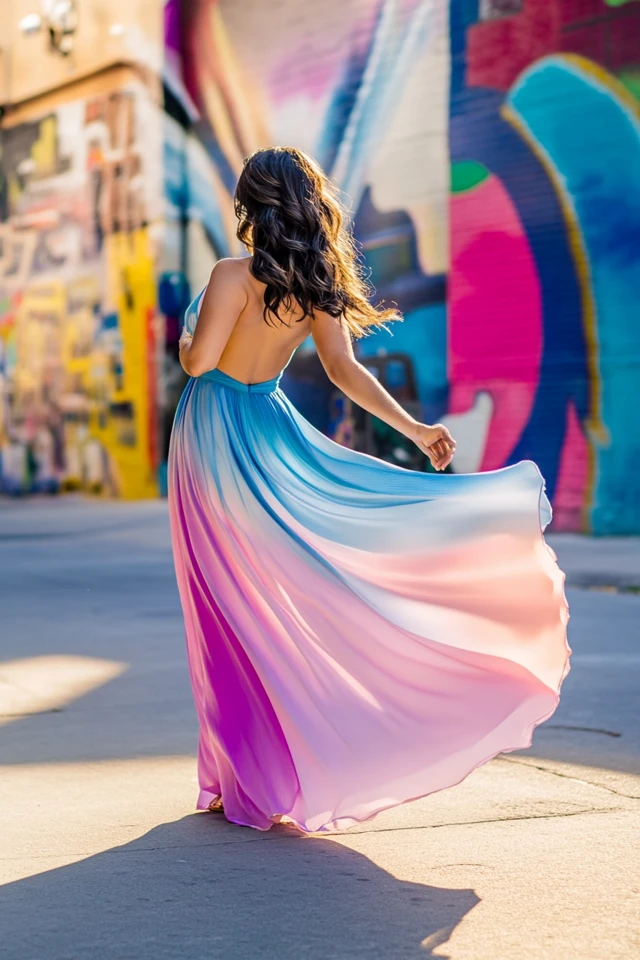Ombre and gradient fashion bring a dynamic and artistic flair to clothing, seamlessly blending colors to create visually stunning transitions. These techniques add depth, movement, and a touch of sophistication to outfits, making them perfect for expressing individuality and creativity in your wardrobe. This comprehensive guide explores the essence of ombre and gradient fashion, highlights essential pieces, offers practical styling tips, and provides inspirational ideas to help you confidently incorporate color transitions into your everyday and special occasion looks.
Introduction
Ombre and gradient fashion have surged in popularity, captivating fashion enthusiasts with their ability to transform simple garments into eye-catching masterpieces. Originating from the French word “ombrer,” meaning “to shade,” ombre refers to the gradual blending of one color hue to another, usually moving from light to dark. Gradient fashion extends this concept by incorporating multiple color transitions, creating intricate and mesmerizing effects.
About the Author and My Trend Boutique
Embracing ombre and gradient styles allows you to play with color in innovative ways, adding a sense of fluidity and elegance to your outfits. Whether you’re looking to make a bold statement or add subtle highlights to your look, ombre and gradient fashion offer versatile options for all occasions and seasons. This guide will equip you with the knowledge and inspiration needed to master these colorful techniques, ensuring your wardrobe remains vibrant and stylish.
Understanding Ombre and Gradient Fashion
What Are Ombre and Gradient?
Ombre and gradient are color techniques used in fashion to create smooth transitions between different shades or colors within a single garment. While the terms are often used interchangeably, they have subtle distinctions:
- Ombre: Typically involves a two-tone transition, moving from one color to another in a gradual manner. For example, a dress that fades from white at the top to black at the bottom.
- Gradient: Refers to a more complex blending of multiple colors, creating a seamless flow through several hues. An example would be a skirt that transitions through various shades of blue, from light sky blue to deep navy.
The Appeal of Ombre and Gradient Fashion
- Visual Interest: The seamless color transitions add depth and movement to garments, making them stand out.
- Versatility: Ombre and gradient styles can be applied to a wide range of clothing items, from dresses and tops to accessories and footwear.
- Personal Expression: These techniques allow for creative expression, enabling you to experiment with different color combinations and styles.
- Modern Aesthetic: Ombre and gradient fashions offer a contemporary look that aligns with current trends, making them suitable for various settings.
Essential Ombre and Gradient Pieces
1. Ombre Dresses
Description: Ombre dresses feature a gradual color transition, often from light to dark or from one hue to another. They come in various styles, including maxi, midi, mini, wrap, and sheath dresses.
Why They’re Essential:
- Statement Piece: An ombre dress can be the focal point of any outfit, making a bold fashion statement.
- Versatility: Suitable for both casual and formal occasions, depending on the fabric and styling.
- Timeless Elegance: Offers a classic yet modern look that remains stylish year after year.
Styling Tips:
- Pair an ombre maxi dress with neutral accessories to let the dress shine.
- Combine a shorter ombre dress with heels and a clutch for an elegant evening look.
- Layer with a solid-colored cardigan or jacket to add dimension and warmth.
2. Gradient Tops and Blouses
Description: Gradient tops and blouses showcase a smooth transition between multiple colors, adding a unique and artistic touch to your wardrobe.
Why They’re Essential:
- Creative Expression: Allows you to experiment with various color palettes and designs.
- Easy Integration: Can be paired with solid-colored bottoms to balance the look.
- Versatility: Suitable for both office wear and casual outings.
Styling Tips:
- Tuck a gradient blouse into high-waisted trousers for a polished office look.
- Pair a gradient t-shirt with jeans and sneakers for a relaxed, everyday outfit.
- Layer with a solid-colored blazer or denim jacket to complement the gradient effect.
3. Ombre Skirts
Description: Ombre skirts feature a color transition that adds movement and flair to the lower half of your outfit. They come in various lengths and materials, from flowing chiffon to structured denim.
Why They’re Essential:
- Dynamic Silhouette: Adds visual interest and elongates the legs.
- Versatility: Can be styled for both daytime and nighttime looks.
- Seasonal Adaptability: Suitable for different seasons with appropriate fabric choices.
Styling Tips:
- Pair an ombre midi skirt with a tucked-in blouse and heels for a sophisticated look.
- Combine a denim ombre skirt with a graphic tee and ankle boots for a casual vibe.
- Accessorize with a belt to define the waist and enhance the overall silhouette.
4. Gradient Outerwear
Description: Gradient outerwear includes jackets, coats, and cardigans that transition through various colors, adding a striking layer to your outfits.
Why They’re Essential:
- Statement Layer: Makes outerwear the centerpiece of your ensemble.
- Versatility: Can be paired with both solid and patterned garments.
- Seasonal Transition: Ideal for layering during transitional weather.
Styling Tips:
- Wear a gradient trench coat over a monochromatic outfit to introduce color without overwhelming.
- Pair a gradient denim jacket with a solid-colored dress for a balanced and stylish look.
- Layer a gradient cardigan over a simple t-shirt and jeans for added warmth and interest.
5. Ombre Accessories
Description: Accessories such as scarves, handbags, belts, and shoes with ombre or gradient effects can enhance and personalize your outfits.
Why They’re Essential:
- Subtle Enhancement: Adds a touch of color and shimmer without dominating the look.
- Versatility: Easy to mix and match with various outfits and styles.
- Personalization: Allows for creative expression through unique and colorful accents.
Styling Tips:
- Add an ombre scarf to a solid-colored coat for a pop of color and texture.
- Choose gradient shoes to complement a monochromatic outfit and add visual interest.
- Use an ombre handbag to introduce a bold accent to a neutral ensemble.
Styling Tips for Ombre and Gradient Fashion
1. Start with a Single Gradient Piece
Begin by incorporating one gradient or ombre piece into your outfit. Let this item be the focal point, and pair it with solid colors to maintain balance and prevent the look from becoming too busy.
- Example: Wear a gradient blouse with black trousers and neutral shoes for a chic and balanced outfit.
2. Mix Patterns and Gradients
Combine gradient pieces with subtle patterns to add depth and interest without overwhelming the ensemble. Ensure that the patterns and gradients share a common color to maintain harmony.
- Example: Pair a gradient skirt with a striped top in one of the gradient colors for a cohesive and stylish look.
3. Balance Bold Colors with Neutrals
When working with bold gradient colors, balance them with neutral tones like black, white, gray, beige, or navy. Neutrals help ground the outfit and allow the gradient piece to stand out.
- Example: Combine a vibrant ombre dress with a beige cardigan and nude heels for a sophisticated and balanced look.
4. Play with Textures and Fabrics
Incorporate different textures to enhance the visual appeal of your gradient outfits. Mixing materials like silk, denim, leather, and knitwear adds dimension and keeps the look interesting.
- Example: Wear a gradient silk blouse with a chunky knit cardigan and denim jeans for a balanced mix of textures.
5. Layering Techniques
Layering can help integrate gradient pieces seamlessly into your outfits. Use jackets, cardigans, or scarves in complementary colors to add depth and warmth.
- Example: Layer a gradient cardigan over a solid-colored dress and add ankle boots for a stylish and cozy ensemble.
6. Consider Your Skin Tone
Choose gradient colors that complement your skin tone to enhance your natural features. Warm skin tones often look great in gradients featuring reds, oranges, and yellows, while cool skin tones are flattered by blues, purples, and greens.
- Example: If you have a warm undertone, opt for a gradient dress that transitions from gold to red to highlight your complexion.
7. Maintain Proportions
Ensure that the proportions of your outfit are balanced when incorporating gradient pieces. If you’re wearing a voluminous gradient skirt, pair it with a fitted top, and vice versa.
- Example: Combine a flowy gradient blouse with slim-fit jeans to create a balanced and flattering silhouette.
8. Accessorize Thoughtfully
Choose accessories that complement your gradient pieces without overpowering them. Opt for metallics, neutrals, or complementary colors to enhance the overall look.
- Example: Add a silver statement necklace to a gradient dress to introduce a touch of glamour without clashing with the color transitions.
9. Embrace Minimalism
Sometimes, less is more when it comes to gradient fashion. Embrace a minimalist approach by allowing one gradient piece to shine while keeping the rest of your outfit simple and understated.
- Example: Wear a gradient skirt with a plain white blouse and minimal jewelry for an elegant and effortless look.
10. Confidence is Key
Wearing gradient and ombre pieces requires confidence. Embrace your unique style and wear your gradient garments with assurance. The more comfortable and confident you feel, the more effortlessly stylish your outfit will appear.
Practical Advice for Incorporating Ombre and Gradient Fashion
1. Invest in Quality Gradient Pieces
High-quality gradient garments and accessories not only look better but also last longer. Invest in well-made pieces that maintain their color transitions and fabric integrity through multiple wears and washes.
- Example: Choose a gradient silk blouse from a reputable brand to ensure vibrant colors and durable fabric.
2. Understand Color Transitions
Familiarize yourself with how different colors blend and transition in ombre and gradient styles. Understanding the flow of colors helps in selecting pieces that complement each other and fit well within your overall wardrobe.
- Example: Learn how a transition from blue to green in a gradient dress can be paired with accessories in one of those hues for a cohesive look.
3. Start with Subtle Gradients
If you’re new to gradient fashion, start with subtle transitions and softer colors. Gradual and muted gradients are easier to integrate into existing outfits and can be less intimidating.
- Example: Wear a blouse with a light ombre effect from white to pale pink paired with neutral bottoms.
4. Mix with Solid Colors
Pair gradient pieces with solid-colored garments to create a balanced and harmonious outfit. Solid colors provide a stable base that allows the gradient piece to stand out without clashing.
- Example: Combine a gradient skirt with a solid black top and black heels for a sleek and sophisticated look.
5. Utilize Monochromatic Gradient Looks
Create a monochromatic gradient outfit by mixing different shades and tones of the same color. This approach adds depth and interest while maintaining a unified color palette.
- Example: Pair a gradient light blue sweater with dark blue jeans and navy accessories for a cohesive monochromatic ensemble.
6. Experiment with Accessories
Use gradient accessories like scarves, bags, or shoes to introduce color transitions into your outfits without committing to full garments. This allows you to experiment with gradient fashion in a more controlled manner.
- Example: Add a gradient scarf to a solid-colored coat and jeans to introduce a pop of color and texture.
7. Consider the Occasion
Tailor your gradient outfits to suit the occasion by selecting appropriate styles and fabrics. Opt for more structured gradient pieces for professional settings and relaxed, flowing garments for casual outings.
- Example: Wear a gradient sheath dress to a business meeting for a polished and stylish appearance, and a gradient maxi dress for a weekend brunch with friends.
8. Layer with Neutrals
Layer gradient pieces with neutral outerwear to balance the look and add sophistication. Neutrals can help ground the vibrant colors of gradient garments and create a harmonious ensemble.
- Example: Layer a gradient cardigan over a white blouse and beige trousers for an elegant and balanced outfit.
9. Maintain Fabric Integrity
Handle gradient fabrics with care to preserve their color transitions and prevent fading. Follow garment care instructions meticulously, especially for delicate materials like silk and chiffon.
- Example: Hand wash or use a gentle cycle for gradient silk blouses to maintain their vibrant colors and smooth texture.
10. Embrace Seasonal Colors
Incorporate gradient pieces that align with seasonal color palettes. Warm gradients with reds, oranges, and yellows are perfect for fall and winter, while cool gradients with blues, greens, and purples suit spring and summer.
- Example: Wear a warm gradient dress transitioning from burgundy to gold during the fall months for a seasonal and stylish look.
Example Outfit Ideas
1. Elegant Office Look
Outfit Components:
- Gradient navy blue blazer (transitioning to teal)
- White button-down blouse
- Black tailored trousers
- Black pumps
- Silver statement necklace
Styling Tips:
- Let the gradient blazer be the focal point by keeping the blouse and trousers in solid, neutral colors.
- Add black pumps for a professional touch and a silver necklace to enhance the outfit without overpowering the gradient effect.
- Complete the look with a structured black handbag for added sophistication.
2. Casual Day Out
Outfit Components:
- Gradient striped t-shirt (transitioning from white to light gray)
- Denim jeans
- White sneakers
- Gradient crossbody bag
- Minimalist silver jewelry
Styling Tips:
- Pair the gradient striped t-shirt with classic denim jeans for a relaxed and comfortable outfit.
- Add white sneakers and a gradient crossbody bag to introduce cohesive color transitions.
- Keep jewelry minimal with silver pieces to maintain a clean and understated look.
3. Evening Glam
Outfit Components:
- Gradient metallic dress (transitioning from silver to gold)
- Black faux leather jacket
- Black stiletto heels
- Metallic clutch
- Statement chandelier earrings
Styling Tips:
- Let the gradient metallic dress shine by pairing it with a black faux leather jacket for contrast and edge.
- Add black stiletto heels and a metallic clutch to enhance the glamorous effect.
- Accessorize with statement chandelier earrings to add a touch of elegance without overshadowing the dress.
4. Weekend Brunch
Outfit Components:
- Gradient wrap dress (transitioning from blush pink to deep rose)
- Beige trench coat
- Nude ankle boots
- Gradient tote bag
- Delicate gold necklace
Styling Tips:
- Wear the gradient wrap dress for a flattering and comfortable brunch outfit.
- Layer with a beige trench coat to add warmth and a neutral balance to the vibrant gradient.
- Pair with nude ankle boots and a gradient tote bag to maintain a cohesive and stylish look.
- Add a delicate gold necklace to introduce subtle shine and elegance.
5. Boho Vibes
Outfit Components:
- Gradient paisley blouse (transitioning from purple to blue)
- Flowing white maxi skirt
- Brown suede ankle boots
- Gradient fringed bag
- Layered beaded necklaces
Styling Tips:
- Combine the gradient paisley blouse with a flowing white maxi skirt for a bohemian-inspired ensemble.
- Add brown suede ankle boots to introduce warmth and texture to the outfit.
- Carry a gradient fringed bag to enhance the boho aesthetic with a touch of shimmer.
- Layer beaded necklaces to add depth and complement the gradient patterns.
6. Smart Casual Look
Outfit Components:
- Gradient geometric patterned top (transitioning from black to gray)
- White tailored trousers
- Black loafers
- Gradient belt
- Subtle metallic watch
Styling Tips:
- Pair the gradient geometric top with white tailored trousers for a smart and stylish casual outfit.
- Add black loafers to maintain a polished appearance and introduce a neutral balance.
- Cinch the waist with a gradient belt to add a coordinated metallic element.
- Wear a subtle metallic watch to complete the ensemble with sophistication.
Picture Gallery
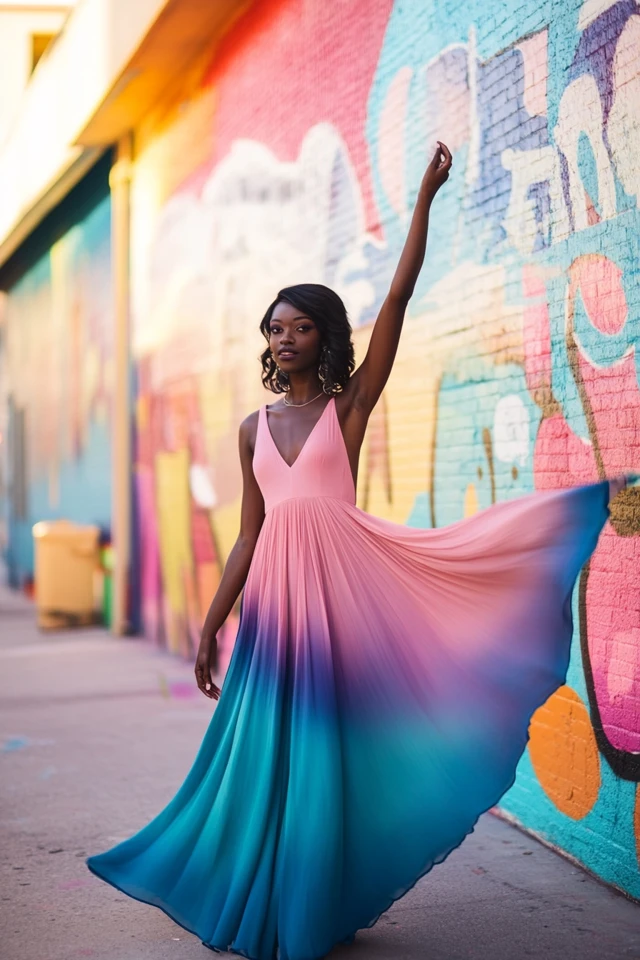
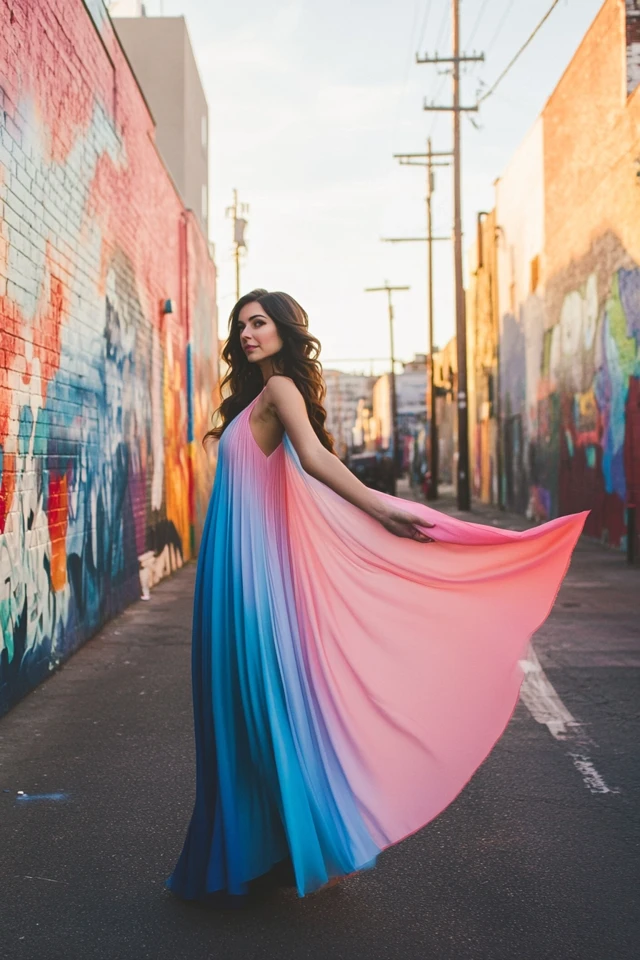


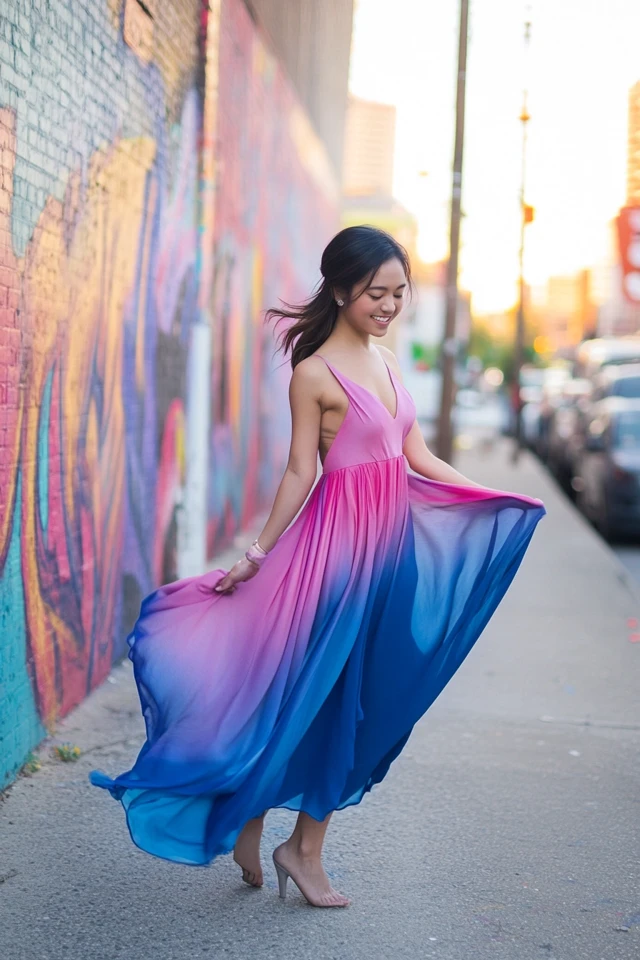
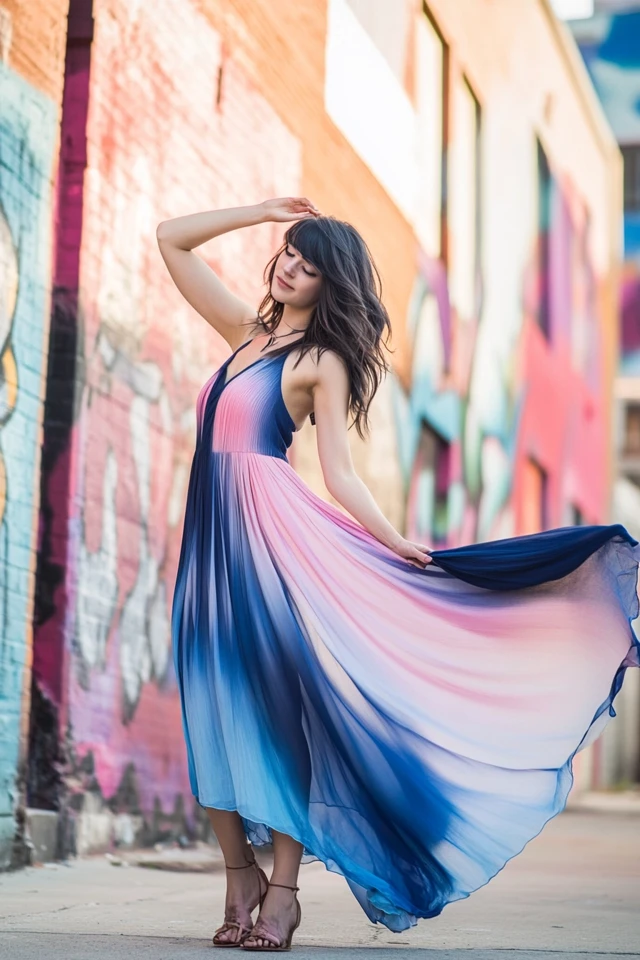
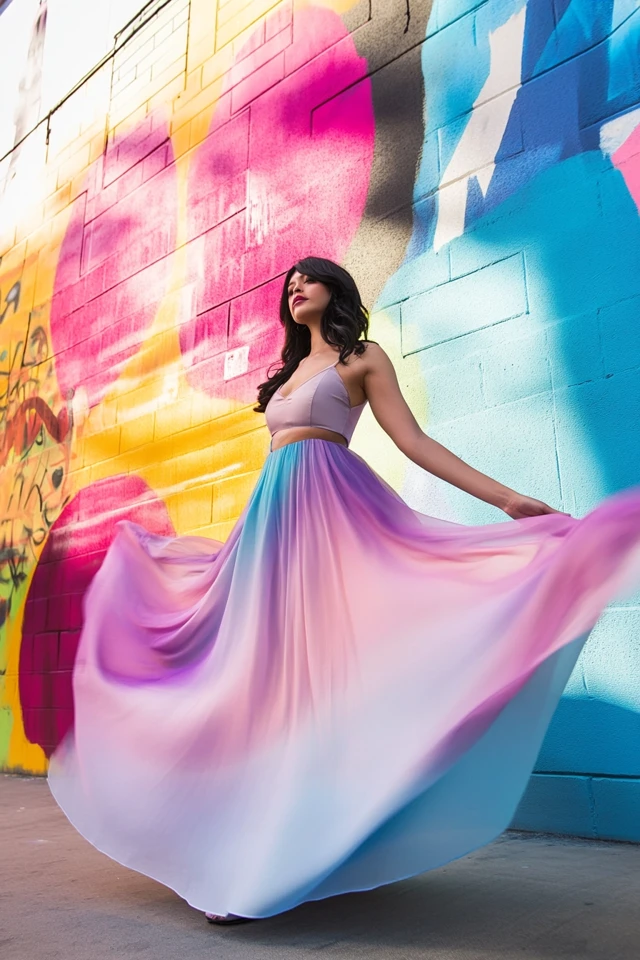
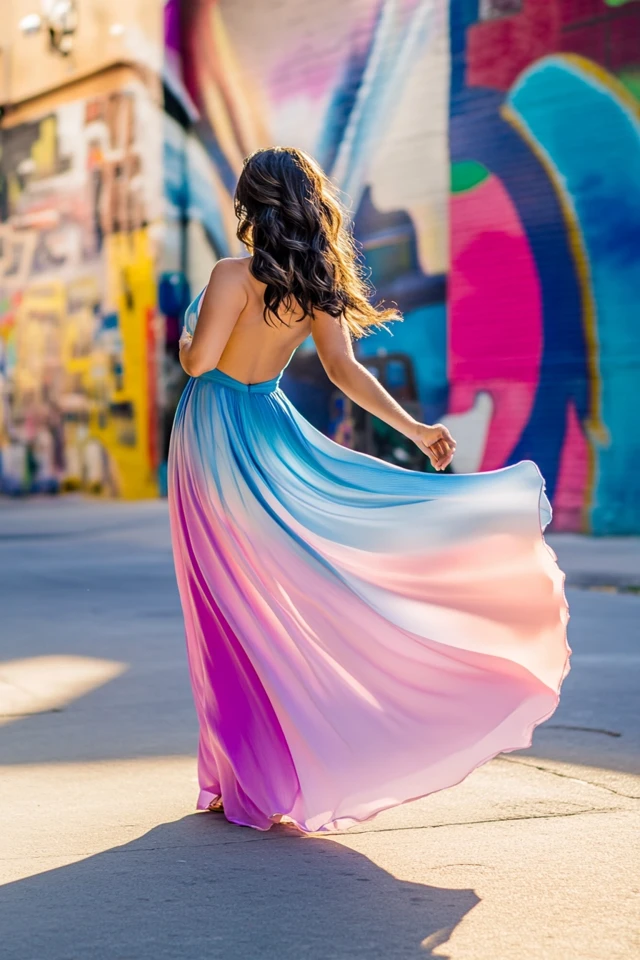

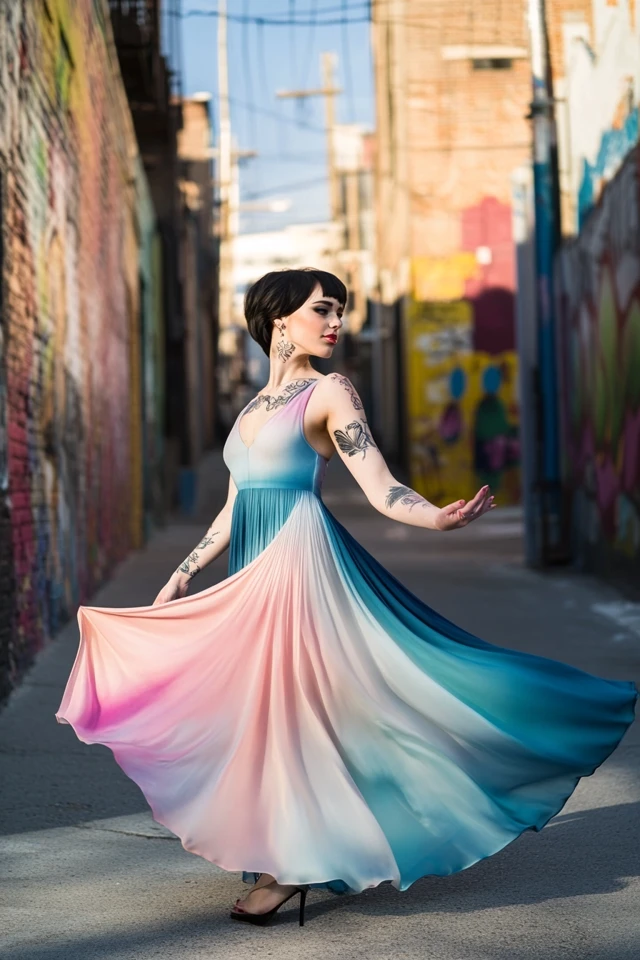

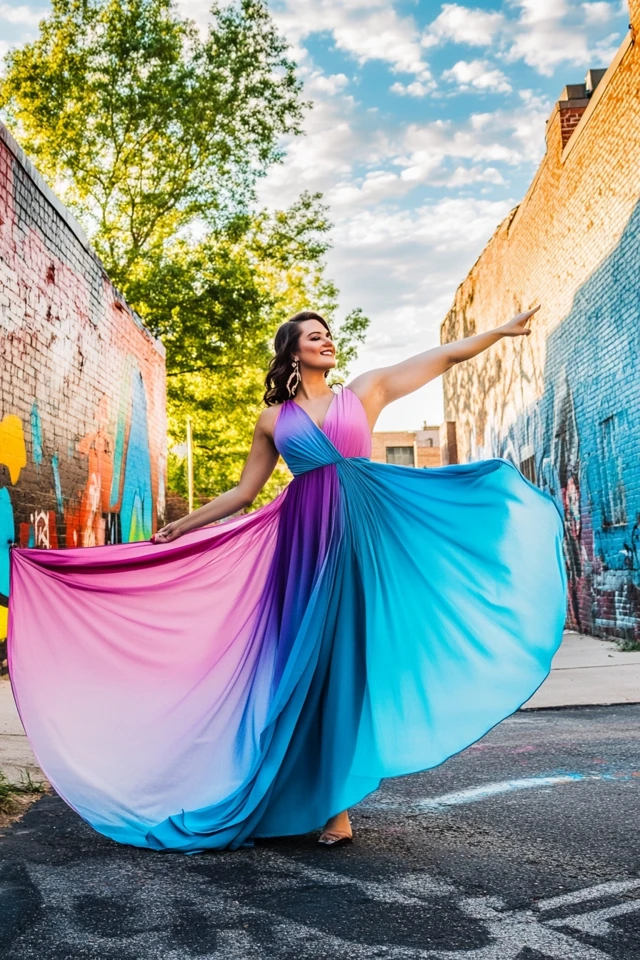
FAQs
1. How do I choose the right gradient piece for my body type?
- Answer: Select gradient pieces that complement your body shape. For example, if you have an hourglass figure, a gradient wrap dress can accentuate your waist. For a pear-shaped body, opt for gradient tops paired with darker bottoms to balance proportions. Consider the garment’s silhouette and how the color transitions enhance your natural features.
2. Can I mix different gradient pieces in one outfit?
- Answer: Yes, you can mix different gradient pieces, but it’s important to maintain balance. Stick to similar color palettes or ensure that the gradients complement each other. For instance, pair a gradient top transitioning from blue to green with a gradient skirt transitioning from yellow to orange, ensuring there are overlapping or harmonious colors.
3. What are some common mistakes to avoid when wearing gradients?
- Answer: Common mistakes include:
- Overloading with Gradients: Wearing too many gradient pieces can create a chaotic look.
- Clashing Colors: Choosing gradients that clash or don’t complement each other can disrupt the harmony of the outfit.
- Ignoring Proportions: Not balancing the scale of gradient patterns with the rest of the outfit can make the look uneven.
- Poor Fit: Gradient garments that don’t fit well can detract from the overall appearance.
4. How can I transition gradient outfits from day to night?
- Answer: Transition gradient outfits by adding or removing certain accessories and swapping footwear. For example, add a statement necklace and heels to a gradient dress for an evening look, or layer with a stylish blazer and switch to ankle boots for a more casual daytime appearance. Metallic accessories can also enhance the transition by adding sparkle and sophistication.
5. Are gradients suitable for all seasons?
- Answer: Yes, gradients are versatile and can be adapted for all seasons. Light and pastel gradients are perfect for spring and summer, adding a fresh and airy feel. Rich and warm gradients work well in fall and winter, providing depth and coziness. Choose fabrics and colors that align with the seasonal weather and trends to make the most of gradient fashion year-round.
Picture Gallery
(Include additional images highlighting the versatility of ombre and gradient fashion in different settings, such as office environments, evening events, casual outings, and boho styles.)
Conclusion
Ombre and gradient fashion offer a dynamic and artistic approach to color in clothing, allowing you to create unique and visually captivating outfits. By understanding the principles of color transitions, selecting essential gradient pieces, and applying thoughtful styling techniques, you can confidently incorporate ombre and gradient styles into your wardrobe. Whether you’re aiming for a subtle shimmer or a bold color statement, these techniques provide endless possibilities for expressing your personal style with elegance and creativity.
Embrace the fluidity and sophistication of ombre and gradient fashion, experiment with different color combinations and patterns, and let your outfits reflect the beautiful transitions that these techniques embody. With practice and confidence, print mixing and color transitions can become a natural and enjoyable aspect of your fashion repertoire, enhancing your overall style and making your ensembles stand out with grace and flair.
Happy styling, and may your ombre and gradient outfits bring vibrancy, depth, and endless fashion possibilities to your everyday looks!

